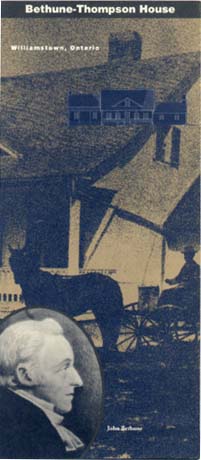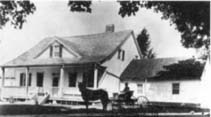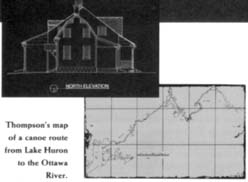Bethune Thompson House
Williamstown, ontario.Photo Caption; The cover of the hand out circular on the

Two Centuries of History Brought to Life,
Situated ninety kilometres east of Ottawa, in the village of Williamstown, the Bethune -Thompson House evolved from an early settler's residence of the 1780s to become one of the most distinctive structures of its kind in Ontario. It served as the manse of the Reverend John Bethune, the first Presbyterian Minister in Upper Canada, and later became home to the well known cartographer and explorer David Thompson, whose accomplishments included mapping major travel routes in both Canada and the United States."
In Consequence of His loyalty
".A tenant farmer who remained loyal to the Crown and saw active service during the Revolutionary War, Peter Ferguson was granted a prime area of land along the Raisin River in Upper Canada as compensation for losses incurred "in consequence of his loyalty".
Unlike the more common log house, the structure Ferguson built around 1784 was in the French Canadian 'poteaux sur sol' style. Heavy, squared timbers were set vertically into a sill and top plate. The sparse interior was highlighted by a large, fieldstone fireplace which served simultaneously as lamp, furnace and stove. Ferguson's land also became the site of the first stone Presbyterian church in Upper Canada. Ferguson, his wife and four children lived in their simple rectangular home until 1804.
The Reverend John Bethune
The Reverend John Bethune, born in Scotland, came to the Williamstown area in 1787. The stone church served as the gathering place for his parishioners, and in 1804 all of Ferguson's property, including his house, was conveyed to Bethune.
Bethune required a manse for his church. Due to his status in the community, as well as the size of his family, the Ferguson house was inadequate.
As a result, a new, much larger home was built incorporating the original Ferguson house as the kitchen wing.
Bethune's manse seems remarkably to have absorbed all the potential influences available at its locale and period. His wife Veronique sold it soon after his death in September, 1815.
Photo Caption; An earlier view of the House, 1913

David Thompson
David Thompson was a renowned cartographer, astronomer and surveyor. He served on the Boundary Commission, mapped travel routes covering over 1,700,000 square miles of Canada and the United States, and was a partner in the Northwest Company. He and his wife Charlotte moved into the house in 1815 and resided there for almost twenty years. Thompson drew many of his maps in the north-west room of the house, still known as the Map Room.
Thompson added a verandah along the front of the house, in keeping with the popular Regency style. The front pediment dormer was renovated in the other predominant style of the period, Classical Revival.
Photo Caption; North Elevation of House & Thompson's map of a canoe route
from Lake huron to the Ottawa River.

After moving to Williamstown, the prosperous Thompson entered into a number of business
ventures, including a potash works and blacksmith's shop. All failed and as a result,
by 1836 he had lost ownership of the house. He and his family relocated to Montreal.
After Bethune and Thompson
Farquhar McLennan, a Scottish immigrant, took possession of the house in 1841. Ownership eventually passed to his son Murdoch, who lived in the house with his sister Catherine until his death in 1897.Montreal businessman Farquhar Robertson, Murdoch McLennan's nephew, inherited the house in 1897. Robertson and his wife used the house as a summer and weekend residence. They entertained lavishly, and eventually replaced the north wing with a larger structure. They also covered the wallpapered interior of the Thompson Period with lath and plaster. This second wall has had the effect of preserving two of the wallpapers and the original horizontal wood plank walls in the Parlour and Dining Room. During restoration by The Ontario Heritage Foundation, panels were removed to reveal what can be considered some of the best examples of early 19th century wallpaper in Canada.
Photo Caption;Map of Williamstown Area.

Robertson willed the property to his brother Kenneth in 1929. Two years later, the
new owner hired William Smart to operate the farm. In 1937 Smart bought the house
and surrounding land.
The house passed from Smart to his son William Jr., who, with his wife Mae Smart,
took residence in 1945. Mrs. Smart sold the house to The Ontario Heritage Foundation
in 1977, thus ensuring its continued preservation.
The Bethune-Thompson House Today
The Ontario Heritage Foundation undertook extensive exterior restoration to the house in 1985 and 1986. Interior renovation was carried out in 1990 to allow a custodial tenant to take residence.
Two years of archaeological investigation uncovered a wealth of artifacts, many dating back to the earliest residents.
Photo Caption; The house as it stands today [1991]

Future plans include the installation of an interpretive exhibit in the original Ferguson
portion of the house.
Today, the Bethune -Thompson House remains a fascinating and informative example of
Ontario's rich and varied past. Members of the public are welcome to visit.
For more information, contact David Anderson at (613) 347-7192 or The Ontario Heritage
Foundation at (416) 325-5000.
The Bethune-Thompson House is owned by the Ontario Heritage Foundation, a non-profit
agency of the ontario Ministry of Culture and Communications. The Foundation is committed
to the preservation, protection, and promotion of Ontario's Cultural, archaeological architectural, historical
and natural heritage for the benefit and enjoyment of present and future generations
of Canadians.
1991, The ontario Heritage Foundation
ISBN-07729-8171-X
Back to the History page